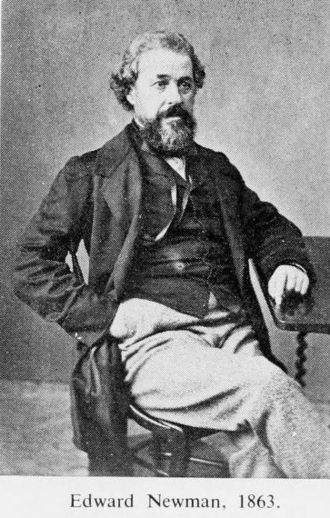
I was skimming through George Barry O’Toole’s The Case Against Evolution (1926) recently, and I was struck by the following sentence (from a chapter on “Homology and its Interpretation”): “In practice, however, the classifications of systematists are often very arbitrary, and we find the latter divided into two factions, the ‘lumpers’ who wish to reduce the number of systematic groups and the ‘splitters’ who have a passion for breaking up larger groups into smaller ones on the basis of tenuous differences.” What struck me about the sentence is not any misrepresentation, but the up-to-date sound of “lumpers” and “splitters”: “these more or less self-evident terms,” as Richard Dawkins describes them in The Ancestor’s Tale (2004), “for taxonomists who habitually lump animals (or plants) into a few large groups, or who habitually split them into lots of small groups.” Calling the terms self-evident, though, obscures their history, which turns out to be complicated and hard to decipher.
Both the Oxford English Dictionary and the Wikipedia article for “Lumpers and splitters” credit the first use of the terms to none other than Darwin, on the strength of a letter he wrote to Joseph Dalton Hooker in 1857:
I am got extremely interested in tabulating according to mere size of genera, the species having any varieties marked by greek letters or otherwise: the result (as far as I have yet gone) seems to me one of the most important arguments I have yet met with, that varieties are only small species—or species only strongly marked varieties. The subject is in many ways so very important for me; I wish much you would think of any well-worked Floras with from 1000–2000 species, with the varieties marked. It is good to have hair-splitters & lumpers.— (emphasis in original)
Indeed, Darwin cited the disagreement between splitters and lumpers itself as evidence for evolution in the second chapter of the Origin: the hypothesis of evolution predicts such difficulties in individuating species.
But even in the Darwin correspondence, “lumpers” and “splitters” are to be found before 1857. The cantankerous botanist Hewett Cottrell Watson (1804–1881)—who, not coincidentally, is thanked by name in the second chapter of the Origin, and was one of the first to congratulate Darwin on its publication—wrote to Darwin in 1855, complaining about the varying use of the term “species” in botany: “Taking J. D. Hooker & [Alexis] Jordan as representative men for the opposite factions in botany,—‘lumpers & splitters’, the former would reduce the species of Vascular plants to three score thousand, or perhaps much fewer;—while Jordan would raise them to three hundred thousand.” So clearly the Oxford English Dictionary and Wikipedia are both mistaken in attributing the terms to Darwin. But it would be premature to attribute them to Watson: the shudder quotes and the lack of any explanation suggest that he was not coining the terms newly in his letter to Darwin.
It’s useful to distinguish three subquestions: in writing about taxonomy, who introduced the term “lumper” (and its cognates such as “lumping”), who introduced the term “splitter” (and its cognates such as “splitting”), and who first used the terms together? I don’t pretend to have definitive answers to any of these questions, especially because the terms probably were used informally before they were ensconced in the scientific literature, but the answers, I suspect, are to be found in nineteenth-century British botany. I start with the simplest case, “lumper.” In a monograph on the British Atripliceae, read in 1840 but not published until 1844 in the Transactions and Proceedings of the Botanical Society of Edinburgh, Charles C. Babington wrote, “…I also find that if the plants are not to be separated by the characters which I have employed, they will require to be reduced to even fewer species than, as I conceive, the most energetic ‘lumper of species’ would venture to recommend.”
“Splitter” isn’t quite so simple, because (as Darwin’s letter to Hooker shows) the term “splitter” was, at least often, a clipping of “hair-splitter” (a term that entered the language around 1820, according to the Oxford English Dictionary, although the idiom “to split hairs” is recorded as early as the 1650s). The earliest taxonomical use I discovered was in Robert Wight and G. A. Walker-Arnott’s Prodromus Florae Peninsulae Indiae Orientalis (1834): “We shall perhaps be severely censured for cutting down species. We have all along considered it as trifling with nature to separate species on slight or variable grounds, nor could we ever understand the ‘cui bono’ for which so much ingenuity in splitting hairs has been wasted.” Darwin’s mentor John Stevens Henslow quoted the passage in his ‘‘On the Requisites Necessary for the Advance of Botany’’ (1836). But the hair was sometimes lost. For example, in 1845, Watson referred to “those botanists who labour under the ‘species-splitting’ monomania.”
But as for the first person to mention lumpers and splitters in the same breath, the credit is due (as far as I can tell) to Edward Newman (1801–1876). A keen naturalist, Newman specialized originally in entomology and later in ornithology, and edited and published a variety of scientific journals. (He was the editor of the Zoologist in 1861 and wrote its review of the Origin. A Quaker, Newman was unhappy with Darwin’s secular approach: “It is one thing to avoid carping at apparent scientific inaccuracies of the Scriptures and another to carelessly pass by and ignore all reference to Revelation.”) He also founded The Phytologist, a botanical journal. In its pages in 1845, he wrote, “The time has arrived for discarding imaginary species, and the duty of doing this is as imperative as the admission of new ones when such are really discovered. The talents described under the respective names of ‘hair-splitting’ and ‘lumping’ are unquestionably yielding their power to the mightier power of Truth.”
Can you find anything earlier?

